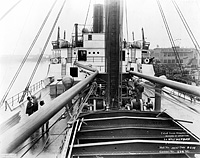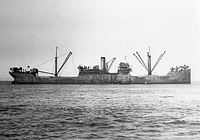EFC Design 1066: Notes & Illustrations

Click here for larger and more complete plans: Sheet 1, Sheet 2
Click on the photographs below to prompt larger views of the same images.
|
Notes: During 1916-1917 British and French interests placed orders for twelve 8800-ton cargo ships (nine of them for the British) with the J. F. Duthie & Co. of Seattle, Wash. These were requisitioned by the Shipping Board on 3 August 1917 while under construction or on order. On 15 March 1918 the EFC issued a contract to Duthie for ten more ships (EFC Hulls 1471-1480) to follow the requisitioned ones. A list of EFC designs dated 19 June 1918 stated that these were to be of Design 1066, which it described as Design 1013 modified by Duthie. (Design 1080 was a similar modification of Design 1013 by the Ames Shipbuilding & Drydock Co.) On 28 May 1918, too late to be included on the June design list, the EFC added a contract for another five ships, EFC Hulls 2602-2606. Lists of designs from August 1919 and later however showed EFC Hulls 1471-1480 as Design 1013 ships and EFC Hulls 2602-2606 as Design 1066 ships. In October 1919 EFC Hulls 2604-2606 were cancelled, leaving only two official Design 1066 ships to be completed. A comparison of the specifications of Designs 1013 (including EFC 1476-80) and 1066 as listed in 1925 reveals no significant differences aside from a 6-inch increase in depth of hull , but photographs and plans show that Design 1066 had a different configuration of the amidships (bridge) house which caused an easily visible rearrangement of the ship's lifeboats. Interestingly these revisions also appear on the only two ships of the March 1918 Duthie contract for which photos have been found, West Hepburn and Seattle Spirit. Duthie built only two more ships, both small, after the war. Requisitioned Sisters: None. The twelve requisitioned ships built by Duthie (Yard nos. 8-12 and 14-20) were considered by the EFC to be of Design 1013, not 1066, when they were offered for sale in 1925. These are mentioned on the Design 1013 page and are covered in the Requisitioned Ships portion of the McKellar list. Specifications: Design 1066 (S.S. West Campgaw, EFC Hull 2602): Steel Cargo. Deadweight tons: 8800 designed, 8591 actual. Dimensions: 423.75' length oa, 410.5' pp x 54' beam mld. x 30.25' depth mld., 24.1' draft loaded. Propulsion: 1 screw, 1 reciprocating engine, 3 Scotch boilers, 2800 IHP, 10.5 kts. Configuration: 3-island, 2 decks, 5 holds, 5 hatches. |

| S.S. West Campgaw (Design 1066, EFC Hull 2602) on a trial run on 9 March 1920. Only two ships were officially built to this design, both completed in 1920 by J. F. Duthie & Co., Seattle, Wash.(NARA: RG-19-A-27) (Click photo to enlarge) |
Duthie's similar Design 1013 variant





